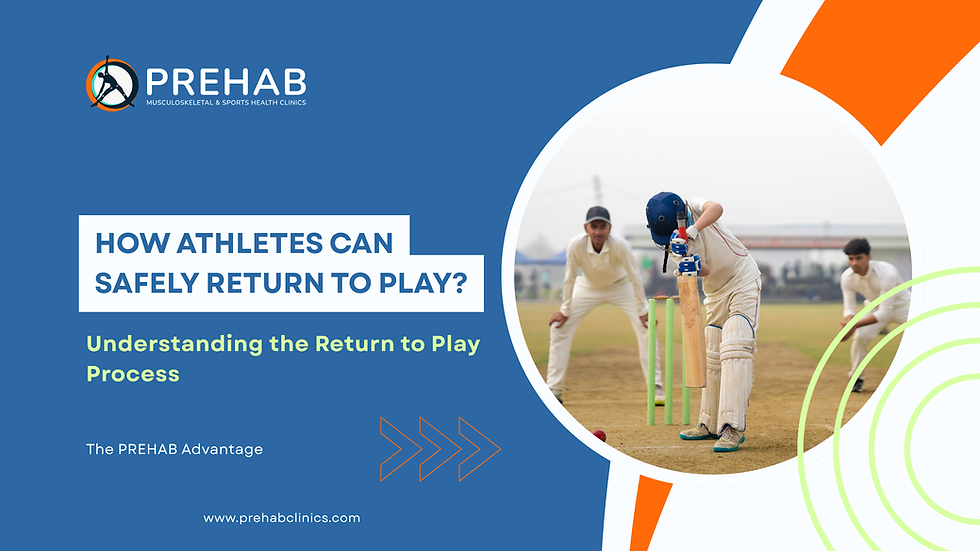Bouncing back strong: Overcoming Recovery Challenges post ACL Surgery
- Prehab

- Aug 27, 2024
- 3 min read
Updated: Dec 16, 2024
ACL surgery can be a daunting experience, but understanding the recovery process and staying focused on overall health can make the journey smoother.

Here’s a guide to help you bounce back strong.
UNDERSTANDING THE RECOVERY PROCESS:
Initial post-surgery protection phase: In the first six weeks, minimize swelling and protect the joint by using walking aids, elevating your knee, wearing a knee brace/cap, and applying ice regularly as advised.
Setting realistic recovery milestones and timelines: Recovery typically takes 28-34 weeks to return to sports. Sports physio sets personalized milestones like regaining range of motion, building strength, and improving proprioception. Gradually reintroduce low- impact exercises and sport-specific drills under careful monitoring to ensure a safe return to full activity. These benchmarks are personalized to your recovery and keep you motivated.
Achieving full recovery: Focus on overall physical, and mental health and wellness. Holistic approach ensures readiness for sports and daily activities with a strong and resilient mindset.
HOW TO UNDERSTAND IF RECOVERY IS ON TRACK & NOT SLOW?
Objective Measures: Use tech-based assessments for muscle strength, ROM, and force development during squats, jumps, single-leg stands, and overall leg functionality.
Track Progress: Regularly log metrics into software to visualize progress through graphs, helping to stay motivated and ensure recovery is on pace.
Adjustments: If progress stalls, adjust your rehab plan by changing exercises, increasing intensity, or seeking additional support from your healthcare provider.
UNDERSTANDING POTENTIAL RISKS FOR SETBACKS:
Pre-operative condition: Before surgery, knee stiffness and muscle weakness can delay recovery. Pre-operative rehab is critical for all elective surgeries.
Complexity of injury: multiple injuries and complex surgeries can slow recovery.
Sudden movements: Avoid sudden twisting knee movements post-surgery using a knee brace or knee cap.
Over doing rehabilitation exercises: Most common factor for setbacks!
Balancing the intensity of exercises is crucial to prevent setbacks during ACL Recovery.
Overdoing exercises can stress joints and cartilage, leading to inflammation and joint
swelling which will need off-loading time to reduce.
Post that, if the intensity of exercises is not managed, the cycle of setbacks repeats,
which in turn slows progress in the long run. Conversely, underdoing exercises may
result in insufficient rehabilitation. Consistent rehab under physiotherapist guidance is
essential to managing the exercise program and promoting a smooth recovery process.
AVOIDING COMMON MISTAKES
Rushing the recovery process: Everyone wants to recover faster!
Patience is crucial; pushing your knee too hard or returning to activities prematurely can
harm the healing graft or knee and delay full recovery. Stick to your timeline and allow
your knee to heal completely.
Progress to the next milestone is based on specific criteria set by your physiotherapist.
Adhering to these criteria ensures a safe and effective rehab process, minimizing the risk
of setbacks.
Criteria include:
● Clinical parameters, i.e., pain, swelling, instability, etc.
● Muscles strength and symmetry compared to normal leg
● Loading symmetry on the operated leg.
● Specific functional tests to compare operated versus normal leg etc.
Neglecting proper nutrition and hydration: Proper nutrition and hydration are crucial post-surgery, supporting tissue repair, muscle strength, and reducing swelling.
Disregarding Doctor's recommendations and Physiotherapist advice: Doctor’s and physiotherapist’s tailored guidance based on your condition and progress; disregarding it may lead to improper healing, prolonging recovery.
SUMMARY:
In conclusion, recovering from ACL surgery requires patience and a holistic approach. Set realistic milestones, track progress, and follow professional advice. Prioritize physiotherapy followed by strength training for strength and stability, and maintain mental resilience. Prevent setbacks by understanding risks and avoiding mistakes. Focus on long-term health for a confident return to activities and sports.
FAQs:
1. How long does it take to recover from ACL surgery?
Recovery typically takes about 28-34 weeks to return to sports, but individual recovery
times vary based on factors like the type of operation, rehabilitation progress and
adherence to post-surgery protocols.
2. What are the most common challenges faced during ACL surgery recovery?
Common challenges include managing pain and swelling, regaining full range of motion
and strength, maintaining patience during the rehabilitation process, and preventing re-
injury.
3. What can I do to speed up my recovery process after ACL surgery?
To expedite recovery, follow your PREHAB rehabilitation plan diligently, focus on proper
nutrition and hydration, avoid overexertion, adhere to your protocol, and use
technology to monitor progress.
4. Is it normal to experience setbacks during ACL surgery recovery?
Yes, setbacks like increased pain or swelling can occur due to overexertion or
inadequate healing. It's important to address these promptly with PREHAB sports
physiotherapists to adjust your recovery plan as needed.
5. When can I return to sports and physical activities after ACL surgery?
Typically, athletes can return to sports around 28-34 weeks post-surgery, after clearing
all the pre-set criteria to progress irrespective of feeling good recovery. However,
clearance varies based on individual recovery progress and sport-specific demands.



Comments